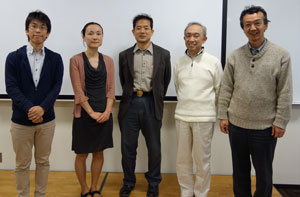IER Activity Log 2018
March 25, 2019 We held an IER seminar
| Date | March 25, 2019 |
| Presenter | Project Professor Vasyl Yoschenko Associate Professor Ismail M.M.Rahman Project Associate Professor Tsugiko Takase Senior Associate Professor Shigekazu Hirao |
| Title | "More details on the progress and future efforts in the forest study”(Yoschenko) “Influence of operating variables on the chelator-induced release of strontium in soils.”(Rahman) “Quantum chemical calculation combined with single crystal X-ray structure analysis : in the case of Chelate complex”(Takase) “Investigation of Triritium behaver in Okuma”(Hirao) |
The last IER seminar of this academic year was held on March 25 with four presenters.
There were 10 people attended including WEB participation. The presentations were made with the various topics involved in the environmental radioactivity,
such as effects of radioactive materials (radiation) on ecosystems, its process and fate.
Project Professor Yoschenko gave more details of his research on the effects of radiation on forests following his oral presentation at the IER Annual symposium held in March.
Associate Professor Rahman reported on the dynamics of Strontium in soil as a collaborative research with Professor Tsukada and Project Associate Professor Takase. Project Associate Professor Takase reported on the analytical method using
“single crystal X-ray structure analysis”. Senior Associate Professor Hirao reported on the observation result of tritium in Okuma Town of this year and his examination.
(Left top)Project Assoc. Prof. Vasyl Yoschenko, (Right top) Assoc. Prof.Ismail M.M.Rahman
(Left bottom)Project Assoc. Prof. Tsugiko Takase, (Right bottom) Senior Assoc.Prof. Shigekazu Hirao
February 25, 2019 We held an IER seminar
| Date | February 25, 2019 |
| Presenter | Project Professor Mark Zheleznyak |
| Title | "Distributed modeling of radionuclide transport in watershed – river systems of Chernobyl and Fukushima regions” |
The IER seminar was held on February 25 by one presenter with 14 attendees.
Project Professor Mark Zheleznyak has been studying computational modeling of radionuclide transport in the natural environment (especially in aquatic environment) in Ukraine, Russia, and Japan. The environmental characteristics largely differ in areas,
the past studies show that not there are not only similarities but also differences in environmental behavior of radionuclides in transport.
Prof. Zheleznyak reported on progress in his research, focusing mainly on the project “Basis for the Environmental Remediation of Radioactively Contaminated Sites,” a 5-year project adopted under SATREPS which is jointly funded by JICA and JST. After the presentation,
Prof. Zheleznyak and participants actively exchanged their opinions
 Project Prof. Mark Zheleznyak
Project Prof. Mark ZheleznyakMarch 2, 2019 10th Dialogue meeting was held in Koriyama
IER held the 10th dialogue meeting in Koriyama city. IER has been holding these meetings since 2016, in order to feedback our research results to local communities.
details: CLICK
December 18, 2018 NIES researchers paid a visit to IER.
Thirty-two researchers belonging to the National Institute for Environmental Studies (NIES) Fukushima branch (Miharu Town) paid a visit to IER.
Established in 2016 as a regional base for conducting research on disasters and the environment, NIES has been conducting
not only research on management of radioactive wastes and environmental impacts of radionuclides,
but also research to support community reconstruction programs in disaster affected areas.
Our faculty members explained the activities and research equipment of IER,
and then took the visitors on facility tour to our analytical laboratory as well as the Faculty of Symbiotic Systems Science building.
Researchers from both institutes actively exchanged opinions on research and organization management during the tour.
IER has been actively promoting cooperative relationships with other universities and research institutes in and outside Japan and will continue sharing knowledge and experience concerning environmental radioactivity research through various occasions such as a visit like this.
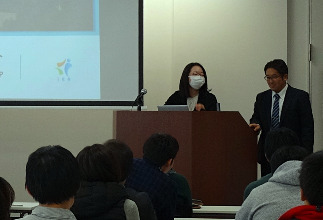

(left)Associate Professor Toshihiro Wada and Project Assistant Professor Hiroko Ishiniwa giving an explanation. Dr. Ishiniwa used to work for NIES.
(right)Project Assistant Professor Tsugiko Takase explaining the capability of analytical instruments.
December 17, 2018 We held an IER seminar
We held an IER seminar
| Date | December 17, 2018 |
| Presenter | Associate Prof. Toshihiro Wada, Prof. Hirofumi Tsukada |
| Title | "Spatial and seasonal
variations of radiocesium concentrations in an algae-grazing annual
fish, ayu Plecoglossus altivelis collected from Fukushima Prefecture
in 2014”(Wada) "Monitoring results of 137Cs activity concentration in Oogaki-dam and its desorption from sediment"(Tsukada) |
An IER seminar was held on December 17 with two presenters. 28 people attended.
Associate Professor Toshihiro Wada talked about the research results on ayu (Plecoglossus altivelis), which has just been published online in Fisheries Science in December 2018.
Ayu is a familiar fish in Japanese food culture. Assoc. Prof. Wada mentioned that ayu could be considered as an “indicator species” showing radiocesium contamination in the environment.
Professor Hirofumi Tsukada reported on the findings of the Ogaki-dam, where he has been conducting research for several years. Ogaki-dam is a reservoir for agricultural irrigation in Namie Town. In the presentation, Prof. Tsukada explicated the causal relationship between dissolved 137Cs activity concentrations and ammonia levels in water.
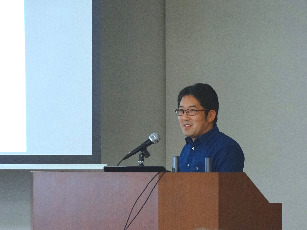
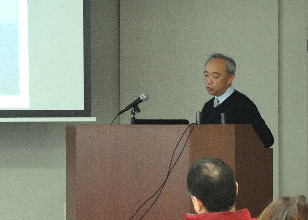
(Left)Assoc. Prof. Toshihiro Wada
(Right)Prof. Hirofumi Tsukada
December 7, 2018 IER held a special seminar
| Date | December 7, 2018 |
| Presenter | Dr. Thomas Johnson (Colorado State University) |
A special seminar was held by Dr. Thomas Johnson, a visiting professor from Colorado State University (CSU).
About 30 people, including Fukushima University students, participated.
Dr. Johnson is a specialist in the area of environmental impacts of radiation and has been in Fukushima since October on JSPS Invitational Fellowship Program,
conducting research and giving a series of lectures at Fukushima University.
This was his last lecture during his stay, in which he talked about the past nuclear accidents and radioactively contaminated sites in the United States, such as Hanford Site in Washington D.C..
Since 2016, IER has been accepting and supporting CSU students with their field research in Fukushima Exclusion Zone.
We anticipate our collaboration will continue to evolve as the graduate course in environmental radioactivity science will start in next April.
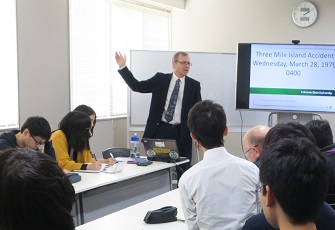
Dr. Thomas Johnson at the lecture
December 3, 2018
We held an IER seminar
| Date | December 3, 2018 |
| Presenter | Prof. Alexei Konoplev, Project Assistant Prof. Hiroko Ishiniwa |
| Title | "Long-term dynamics of radionuclides in rivers: Chernobyl and Fukushima." "The effect of low dose rate radiation on wild mice living in Fukushima evacuation zone" |
This is a report on the IER seminar held on Dec. 3.
Two presenters gave a summary of their research. Thirteen people attended.
Professor Konoplev talked about the measurement of radioactive materials in rivers in Fukushima in comparison with the results from his long-term research in Chernobyl.
Project Assistant Professor Ishiniwa first gave a basic explanation about how radiation affects living organisms, and then talked about the effects of chronic low-level radiation on wildlife that are observed in the environment.
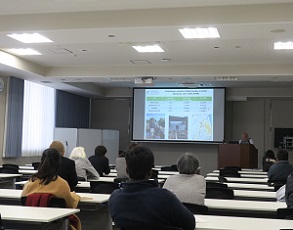

Left:Prof. Alexei Konoplev at the lecture.
Right:Project Assistant Prof. Hiroko Ishiniwa.
December 2, 2018 IER exhibited at the Environmental Creation Symposium
IER exhibited at the second Environmental Creation Symposium that was held at Fukushima Prefectural Centre for Environmental Creation in Miharu.
This symposium aims to introduce to the general public various activities undertaken with a view to contributing to the revitalization of Fukushima and to offer an opportunity where the participants can learn and think about the future of Fukushima.
In addition to the exhibitions by research institutes in Fukushima, there were exhibitions by high school students and civil groups. The venue was visited by many people of all generations.
With a wide range of exhibitions as well as a panel discussion, the event was a good chance for participants to visualize the future of Fukushima.
IER also had a booth introducing our daily activities and some of our specific research topics. A comment we received from a participant who said,
"It is easier to understand when explained face to face" made us rethink our role in disseminating the activities and research outputs of our institute.
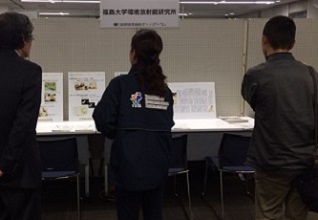
IER’s booth with panels on our activities
November 29, 2018
Five students of University of Tsukuba visited IER
November 29, 2018. Five international students in School of Life and Environmental Sciences and School of Human Sciences in University of Tsukuba visited IER. This visit was part of their fieldwork program. They took a tour in the analytical laboratory, guided by Senior Assistant Professor Yoshifumi Wakiyama, who introduced the brief history of IER and explained how the instruments work.

Students listening to the explanation of Ge detectors.
November 26, 2018
A cooperation agreement was concluded with Faculty of Geography, Moscow State University
On 26 November, IER concluded a cooperation agreement with the Faculty of Geography, Moscow State University (MSU). Established in 1938, MSU Faculty of Geography is a world-known educational and research center with 1200 students including many international students from China, Iran, France, Germany, etc. This agreement aims at sharing of knowledge and expertise obtained through the studies of environmental radioactivity from geographical perspectives, and strengthening research capabilities through exchange of researchers. It is expected that this agreement leads to full-fledged collaboration between the two institutions and joint research for new solutions enabled by adopting approaches that go beyond those of the past.

Left: Prof. Sergey A. Dobrolyubov, Faculty of Geography MSU.
Right: Prof. Hirofumi Tsukada, IER.
November 20, 2018 Prof. Konoplev gave lectures at Fukushima High School.
On 20 November, Prof. Alexei Konoplev gave two lectures at Fukushima Prefectural Fukushima High School. The school, which is designated as Super Science High School (SSH), organized special lectures for the 1st grade students aiming to develop scientific attitudes and ways of thinking. Students could participate in 2 lectures of their choice. More than 70 students, who chose to attend Prof. Konoplev’s lectures conducted in English, listened earnestly and asked questions.

Prof. Alexei Konoplev
November 16, 2018 Dialogue meeting was held in Soma
On November 16, IER held the 9th dialogue meeting in Soma city. IER has been holding these meetings since 2016, in order to feedback our research results to local communities.
details:CLICK
November 15, IER concluded a cooperation agreement with the Graduated School of Natural Science and Technology of Kanazawa University.
On November 15, IER concluded a cooperation agreement with the Graduated School of Natural Science and Technology of Kanazawa University. After this agreement, larger-scale joint researches developed from the present collaborative studies between individual researchers will hopefully be realized by sharing the expertise of each institution. The agreement will also promote the further educational exchange, which will be beneficial for a new Master Course program of IER started in the next April.

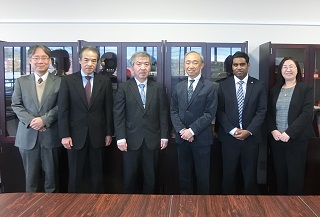
(Left) Left: Prof. Kenichi Aoki, Natural Science and Technology (KU) Right: Prof. Hirofumi Tsukada, IER
(right) This agreement has started from a cooperation research between Prof. Hiroshi Hasegawa (KU, left end) and Associate Prof. Ismail M. M. Rahman. (IER, second from right)
November 15, 2018 A young MEXT trainee official paid to visit to IER
On November 15, IER received a visitor, Ms. Aoki, a young trainee of the
Ministry of Education, Culture, Sports, Science and technology (MEXT) as
parts of the Ministry’s personnel training program. She joined a regular
water sampling at Ryozen area, where one of our research teams is observing
and studying the levels of radioactivity in a river. After returning to
IER, she had a lab tour and received an explanation of activities and role
of IER.
Ms. Aoki commented that by taking part in the actual research activities,
she was able to realize more concretely what IER is aiming at.
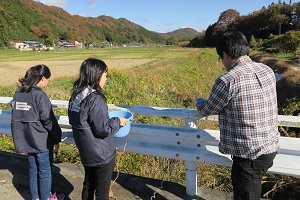

November 5, 2018 Seven students come, from Sapporo Sinyo High School
Seven students from Sapporo Shinyo
High School, located in Sapporo city, Hokkaido, visited IER after they
participated in an event held in Fukushima. This event was organized by a
team of high school students of Fukushima, which is a member of Japan
Innovative Schools Network supported by OECD. Sinyo High School students had
visited different locations in Fukushima, and through what they saw and
heard, they began to want to learn more about the radiation issues faced by
Fukushima. So they decided to visit us.
It was a good opportunity for us to
directly communicate with young people from outside of Fukushima about the
post-accident situation in Fukushima and significance of environmental
radioactivity research and the mission of our institute.



October 25, 2018
A MEXT official paid a visit to IER
On October 25, IER received a visit by Mr. Hirano, Director of Office of
University Reform, Ministry of Education, Culture, Sports, Science and
Technology (MEXT), who was to give a lecture held on campus on this day.
Prof. Takayuki Takahashi, Vice Director of IER, provided an overview of IER
and guided him for a tour in the main building and the analytical
laboratory, where Mr. Hirano observed how the measurement of radioactivity
in environmental samples is conducted.


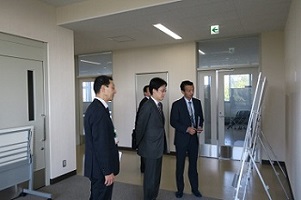
October 19, 2018
17 Students come from ODAKA Industrial Technology and Commerce High School
ODAKA Industrial Technology and Commerce High School is specified as “Super Professional High school FY2018” by MEXT (the Ministry of Education, Culture, Sports, Science and Technology). This school aims to train personnel who are responsible for regional reconstruction through cooperation with companies, universities, etc. The high school students visited and took a tour in our analytical building. Our researchers showed them how to measure radiation by using an NaI scintillation detector, for making students have close to the equipment actually used in field research.
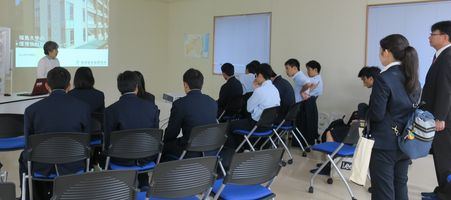
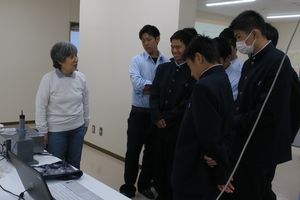
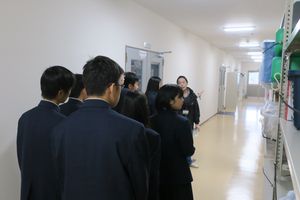
January 2, 2018 MOU was signed with the Department of Chemistry, University of Chittagong, Bangladesh.
A Memorandum of Understanding (MOU) between the Department of Chemistry, University of Chittagong, Bangladesh
and the Institute of Environmental Radioactivity (IER), Fukushima University, Japan was signed in January 2018 at University of Chittagong.
Dr. Ismail M. M. Rahman, Associate Professor of IER, who had taught at University of Chittagong until 2015, attended the signing ceremony
as a proxy of Director Kenji Nanba. Professor, who had signed the MOU on behalf of IER and Dr. Monir Uddin (Chairman, Department of Chemistry) on behalf of the
Department of Chemistry. The other dignitaries present at the signing ceremony were Professor Dr. Iftekhar Uddin Chowdhury (Vice Chancellor), Professor
Dr. Mohammed Kamrul Huda (Registrar), Professor Dr. Mohammad Shafiul Alam (Dean, Faculty of Science) along with the senior professors of the Department of
Chemistry. The MOU will provide opportunities for the researchers of both organizations to share ideas for collaborative research and develop joint research
proposals that are larger in scope and size for Kakenhi and other external fund programs.
Top left: Professor Dr. Monir Uddin, Chairman, Department of Chemistry (front row, second from right),
Professor Dr. Iftekhar Uddin Chowdhury Vice Chancellor, University of Chittagong (front row, center), and
Dr. Ismail M. M. Rahman, IER (front row, second from left) hold the signed MOU after the signing ceremony.
Top right: Dr. Rahman gave a commemorative lecture “Career in Science: Are you ready?” to undergraduate
and graduate students at University of Chittagong.
Professor Shirin Akhtar, Pro-Vice Chancellor, University of Chittagong (center in the picture) inaugurated
the lecture session
Bottom: This commemorative picture showed that Dr. Rahman and Director Nanba holding MOU at our institute.
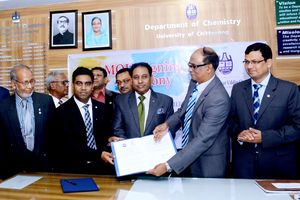


April 14, 2017 IER Open Seminar was held.
Dr. Haruko Wainwright Murakami (Lawrence Berkeley National Laboratory)
Title : Technical Innovations for Environmental Resiliency after the Fukushima Nuclear Power Plant Accident
Date : April 14, 2017
Venue : Donation Memorial Building


